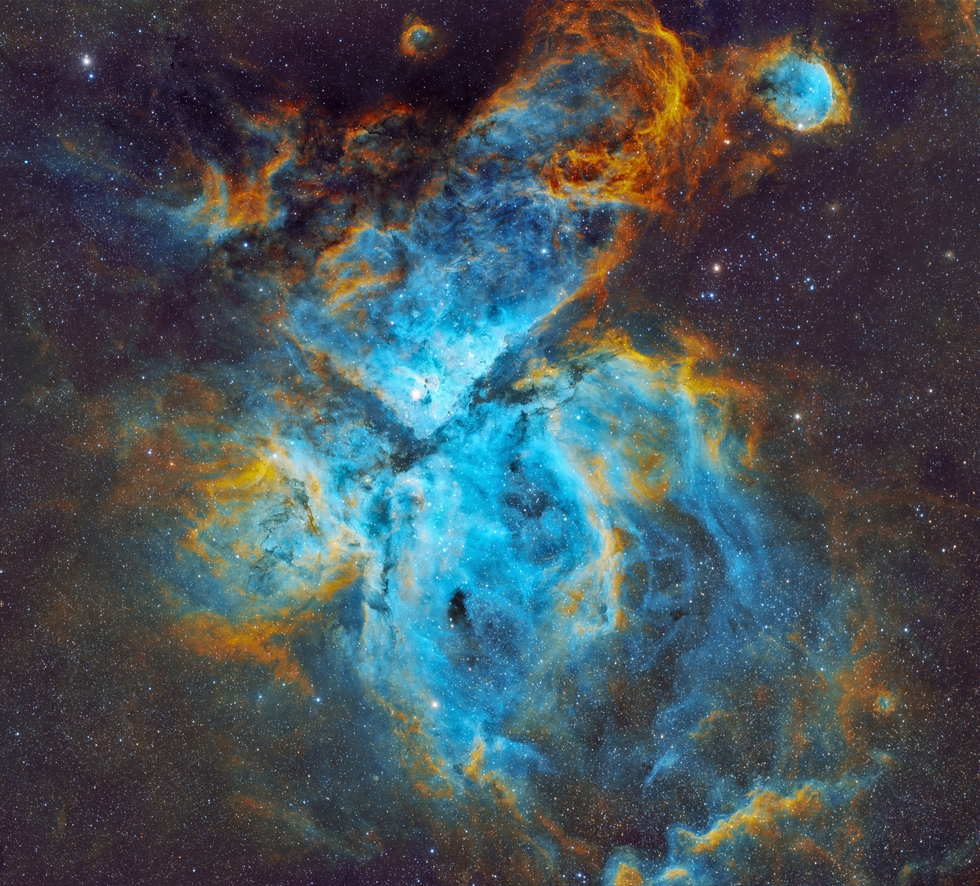Eta Carina W in SHO
Eta Carina W in SHO
This is a wide field image of the Eta Carina Nebula region, a very large active region in the sky of the southern hemisphere. This is from a new Telescope Live dataset, after their AUS-2 telescope has been upgraded with a QHY 600M full frame CMOS camera (previously there was a CCD imager mounted on this telescope, a Takahashi FSQ106).
The pixel size is much smaller with the QHY CMOS camera, and it is a slightly different frame shape/format with much higher resolution per arc-sec than the previous CCD imager. I thought it would be interesting to compare the two since the only difference between them is the imager (CMOS vs CCD).
This image is cropped from the full frame to remove some abberation that is evident in the upper left of the image in this rotated orientation . TL is still working through the issues, and the cause of the aberration seems most likely to the result of sensor tilt since there are no odd shaped stars/aberration evident in the earlier CCD version. I believe the CMOS version captures more fine structure/detail in the image than the CCD version and I had the impression during post processing that there was more color depth. IMO. YMMV.
Please Enjoy!!!
Carina Nebula - Wikipedia
The Carina Nebula or Eta Carinae Nebula (catalogued as NGC 3372; also known as the Great Carina Nebula) is a large, complex area of bright and dark nebulosity in the constellation Carina, located in the Carina–Sagittarius Arm of the Milky Way galaxy. The nebula is approximately 8,500 light-years (2,600 pc) from Earth.The nebula has within its boundaries the large Carina OB1association and several related open clusters, including numerous O-type stars and several Wolf–Rayet stars. Carina OB1 encompasses the star clustersTrumpler 14 and Trumpler 16.
Trumpler 14 is one of the youngest known star clusters at half a million years old. Trumpler 16 is the home of WR 25, currently the most luminous star known in our Milky Waygalaxy, together with the less luminous but more massive and famous Eta Carinae star system and the O2 supergiant HD 93129A. Trumpler 15, Collinder 228, Collinder 232, NGC 3324, and NGC 3293 are also considered members of the association. NGC 3293 is the oldest and furthest from Trumpler 14, indicating sequential and ongoing star formation.The nebula is one of the largest diffuse nebulae in our skies.
Although it is four times as large as and even brighter than the famous Orion Nebula, the Carina Nebula is much less well known due to its location in the southern sky. It was discovered by Nicolas-Louis de Lacaille in 1752 from the Cape of Good Hope.The Carina Nebula was selected as one of five cosmic objects observed by the James Webb Space Telescope, as part of the release of its first official science images. A detailed image was made of an early star-forming region of NGC 3324 known as the Cosmic Cliffs.
The pixel size is much smaller with the QHY CMOS camera, and it is a slightly different frame shape/format with much higher resolution per arc-sec than the previous CCD imager. I thought it would be interesting to compare the two since the only difference between them is the imager (CMOS vs CCD).
This image is cropped from the full frame to remove some abberation that is evident in the upper left of the image in this rotated orientation . TL is still working through the issues, and the cause of the aberration seems most likely to the result of sensor tilt since there are no odd shaped stars/aberration evident in the earlier CCD version. I believe the CMOS version captures more fine structure/detail in the image than the CCD version and I had the impression during post processing that there was more color depth. IMO. YMMV.
Please Enjoy!!!
Carina Nebula - Wikipedia
The Carina Nebula or Eta Carinae Nebula (catalogued as NGC 3372; also known as the Great Carina Nebula) is a large, complex area of bright and dark nebulosity in the constellation Carina, located in the Carina–Sagittarius Arm of the Milky Way galaxy. The nebula is approximately 8,500 light-years (2,600 pc) from Earth.The nebula has within its boundaries the large Carina OB1association and several related open clusters, including numerous O-type stars and several Wolf–Rayet stars. Carina OB1 encompasses the star clustersTrumpler 14 and Trumpler 16.
Trumpler 14 is one of the youngest known star clusters at half a million years old. Trumpler 16 is the home of WR 25, currently the most luminous star known in our Milky Waygalaxy, together with the less luminous but more massive and famous Eta Carinae star system and the O2 supergiant HD 93129A. Trumpler 15, Collinder 228, Collinder 232, NGC 3324, and NGC 3293 are also considered members of the association. NGC 3293 is the oldest and furthest from Trumpler 14, indicating sequential and ongoing star formation.The nebula is one of the largest diffuse nebulae in our skies.
Although it is four times as large as and even brighter than the famous Orion Nebula, the Carina Nebula is much less well known due to its location in the southern sky. It was discovered by Nicolas-Louis de Lacaille in 1752 from the Cape of Good Hope.The Carina Nebula was selected as one of five cosmic objects observed by the James Webb Space Telescope, as part of the release of its first official science images. A detailed image was made of an early star-forming region of NGC 3324 known as the Cosmic Cliffs.
SPECIFICATIONS
Telescope
Takahashi FSQ106 (AUS-2)
Camera
QHY 600M
Location
Heaven's Gate Observatory, Australia
Date of observation
March 2023
Filters
Astrodon 3nm Ha, Sii, and Oiii
Processing
Pixinsight
Credits
Telescope Live


